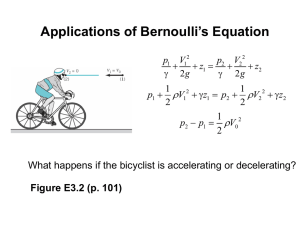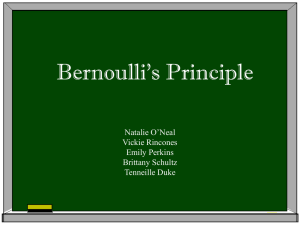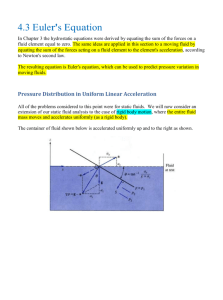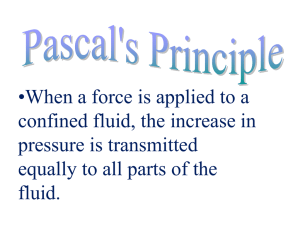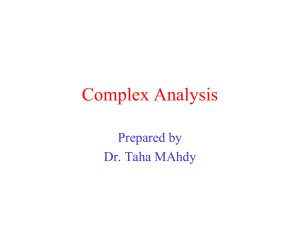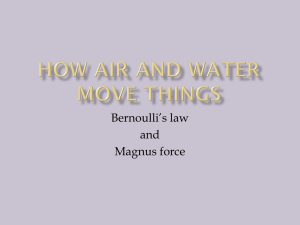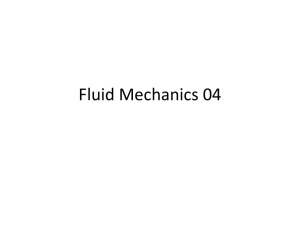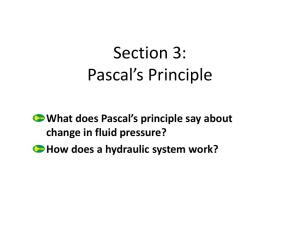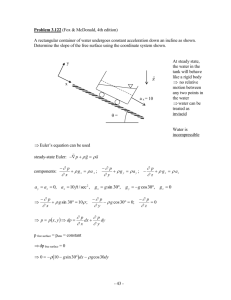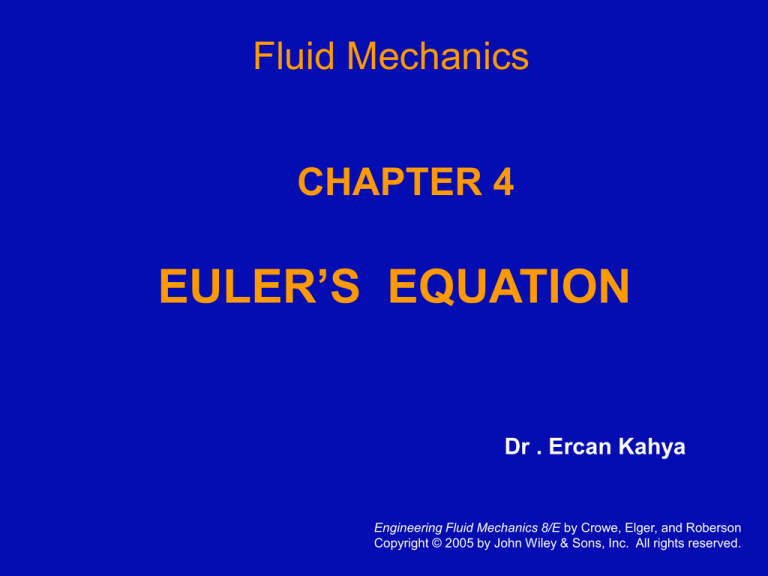
Fluid Mechanics
CHAPTER 4
EULER’S EQUATION
Dr . Ercan Kahya
Engineering Fluid Mechanics 8/E by Crowe, Elger, and Roberson
Copyright © 2005 by John Wiley & Sons, Inc. All rights reserved.
Review of Definitions
• Steady flow:
velocity is constant with respect to time
• Unsteady flow:
velocity changes with respect to time
• Uniform flow:
velocity is constant with respect to position
• Non-uniform flow: velocity changes with respect to position
•Local acceleration:
– change of flow velocity with respect to time
– occurs when flow is unsteady
• Convective acceleration:
– change of flow velocity with respect to position
– occurs when flow is non‐uniform
EULER’S EQUATION
• To predict pressure variation in moving fluid
• Euler’s Equation is an extension of the hydrostatic equation for
accelerations other than gravitational
• RESULTED FROM APPLYING NEWTON SECOND LAW TO A FLUID
ELEMENT IN THE FLOW OF INCOMPRESSIBLE, INVISCID FLUID
Assume that the viscous forces are zero
EULER’S EQUATION
Fl mal
ΔP
γsinα ρa l
Δl
Taking the limit of the two terms at left side at a given time as Δl → 0
( p γz) ρa l
l
ACCELERATION IS IN THE DIRECTION OF
DECREASING PIEZOMETRIC PRESSURE!!!
When “a = 0” → Euler equation reduces to hydrostatic equation!
In the x direction,
for example:
( p γz) ρa x
x
( p γz)2 ( p γz)1 xρa x
“2” and “1” refer to the location with respect to the direction l (When l = x direction, then “2” is
the right-most point. When l = z direction, “2” is the highest point.)
EULER’S EQUATION
An example of Euler Equation is to the uniform acceleration of in a tank:
Open tank is accelerated to the right at a rate ax
For this to occur; a net force must act on the liquid in the x-direction
To accomplish this; the liquid redistributes itself in the tank (A’B’CD)
– The rise in fluid causes a greater hydrostatic force on the left than the right side
→ this is consistent with the requirement of “F = ma”
– Along the bottom of tank, pressure variation is hydrostatic in the vertical direction
EULER’S EQUATION
( p γz) ρa l
l
• The component of acceleration in the l direction: ax cosα
Apply the above equation along A’B’
d
( γz) ρa x Cos
dl
Apply the above equation along DC
ax
t an g
a x Cos
dz
sin
dl
g
Example 4.3: Euler’s equation
A
• The truck carrying gasoline (γ = 6.60 kN/m3) and is slowing down at a rate
of 3.05 m/s2.
• 1) What is the pressure at point A?
• 2) Where is the greatest pressure & at what value in that point?
( p γz) ρa l
l
Solution:
• Apply Euler’s equation along the top of the tank; so z is constant
• Assume that deceleration is constant
• Pressure does not change with time
Along the top the tank
dp
ρa l
dl
Euler’s equation in vertical direction:
(Note that az =0)
d
( p γz) ρa l
dl
p ρa ll C
d
( p γz) ρa z
dz
( pbottom γzbottom ) ( ptop γztop )
Pressure variation is hydrostatic in the vertical direction
Centripetal (Radial) Acceleration
2
Vt
2
ar
r
r
• For a liquid rotating
as a rigid body:
• ar = centripetal (radial) acceleration, m/s2
• Vt = tangential velocity, m/s
• r = radius of rotation, m
• ω = angular velocity, rad/s
V=ωr
Pressure Distribution in Rotating Flow
• A common type of rotating flow is the flow in which the fluid rotates as a
rigid body.
• Applying Euler Equation in the direction normal to streamlines and outward
from the center of rotation (OR INTEGRATING EULER EQUATION IN THE
RADIAL DIRECTION FOR A ROTATING FLOW) results in
p
2r 2
z
2g
C
Pressure variation in
rotating flow
Note that this is not the Bernoulli equation
• When flow is rotating, fluid level will rise away from the direction of net acceleration
Example 4.4:
Find the elevation difference
between point 1 and 2
2 r12 p2
2 r22
z1
z2
2g
2g
p1
p1 = p2 = 0 and r1 = 0 , r2= 0.25m then →
2 r22
z1 z2
2g
z2 – z1= 0.051m & Note that the surface profile is parabolic
Pressure Distribution in Rotating Flow
2 r12 p2
2 r22
z1
z2
2g
2g
p1
Another independent equation;
The sum of water heights in left and
right arms should remain unchanged
p = pressure, Pa
γ = specific weight, N/m3
z = elevation, m
ω = rotational rate, radians/second
r = distance from the axis of rotation
Bernoulli Equation
Integrating Euler’s equation along a streamline in a steady flow of an
incompressible, inviscid fluid yields the Bernoulli equation:
V
2
2g
P
z C
z: Position
p/γ: Pressure head
V2/2g: Velocity head
C: Integral constant
Application of Bernoulli Equation
Bernoulli Equation:
– Piezometric pressure : p + γz
– Kinetic pressure : ρV2/2
For the steady flow of incompressible fluid inviscid fluid
the sum of these is constant along a streamline
Application of Bernoulli Equation: Stagnation Tube
V12 p1 V22 p 2
2g 2g
V
2
1
P1 d
V
2
1
2
2
( P2 P1 )
P2 (l d )
( (l d ) d )
V1 2 gl
Stagnation Tube
V12 p1 V22 p 2
2g 2g
h=V2 /2g
p2/
p1 /
V2=0 & z1 = z2
1
2
V1
p 2 p1
2gh
2g
Application of Bernoulli Equation: Pitot Tube
Bernoulli equation btw static
pressure pt 1 and stagnation pt 2;
V12 p1
V22 p 2
z1
z2
2g
2g
H
1
h1
1
2
V2 = 0 then Pitot tube equation;
V1
p 2 p1
2g
2
p
Stagnation point
p1 h 1 1 h h 1 h p 2
p 2 p1
1
s1
h
1
h
1
s
VENTURI METER
The Venturi meter device measures the flow rate or velocity of a fluid through a
pipe. The equation is based on the Bernoulli equation, conservation of energy,
and the continuity equation.
Solve for flow rate
Solve for pressure differential
Class Exercises: (Problem 4.42)
Class Exercises: (Problem 4.59)

